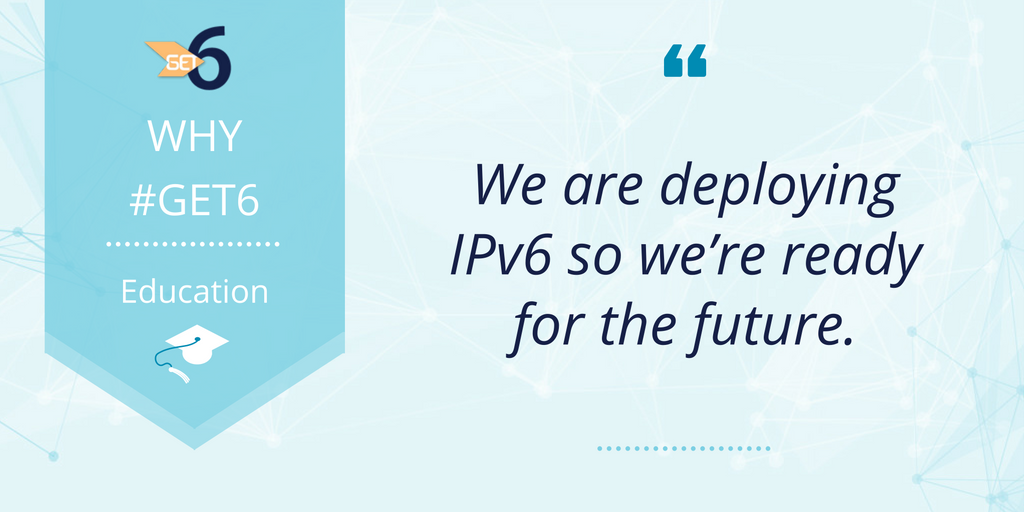
Benefits of Adopting IPv6 [Archived]
OUT OF DATE?
Here in the Vault, information is published in its final form and then not changed or updated. As a result, some content, specifically links to other pages and other references, may be out-of-date or no longer available.
A couple of weeks ago, we shared some of the results of our recent IPv6 deployment survey with you and promised we’d share a few the benefits our respondents gained from deploying the next generation protocol, as well as how they overcame some of their IPv6 adoption challenges.
In our original post we mentioned that only 20% of respondents indicated “cost” as a barrier to IPv6 adoption within their organizations, many citing technical issues as a larger concern. So what is the bigger concern? Technical issues. We asked what would have made deploying IPv6 easier for your organization and the most common responses included the need for a better technical understanding inside the organization, training and documentation. Another common answer was the desire to see more vendor support. A lack of feature parity between IPv4 and IPv6 seems to be a collective pain point in the transition process. More broadly, others indicated they’d like to see an industry-wide consensus to make the move, customer demand, and community support to help drive IPv6 projects inside their own companies. They’d also like to have access to more staffing resources with the appropriate experience. Lastly, people mentioned that a no hassle IPv6 allocation from ARIN would be nice (which we’re happy to note, is indeed available).
Benefits of Deploying IPv6
Even though quite a few respondents suggested the tangible benefits of IPv6 deployment are limited at this time, there were several notable perspectives on the benefits of IPv6 deployment, including:
-
More IP space, obviously
-
Future proofing
-
Bragging rights
-
Staying on the forefront of networking and IT trends
-
Leading by innovation and recognition as market leader, both to customers and peers
-
Ahead of the curve instead of behind it, before IPv6 became a critical network dependency
-
Easier to recruit top engineering talent who want to work for a forward-looking company
-
Access to IPv6 only services
-
Simplified access to endpoints, reduced complexity of internal network
-
Better connectivity and easier expansion of public facing services without NAT
-
Meeting US federal OMB requirements
-
Peer routing on partner networks
-
Easier device management and troubleshooting without multiple instances of RFC1918 space to manage
-
ISP customers are able to be assigned an entire subnet, whereas before they could only obtain a single IP
-
Easier to configure internal services on native IPv6 without using up scarce IPv4 resources
-
Less DNS changes
-
Performance and scale
-
Email seems faster
-
Growth of the IoT
-
Meets the demand for mobile devices
-
Makes people feel like they are good netizens
Overcoming the Challenges to IPv6 Adoption
Realistically every business decision and networking problem has its challenges, and IPv6 deployment is no different. Respondents had some great suggestions on how to overcome IPv6 challenges. In a nutshell, here are few recommendations:
-
Just start hacking away at it
-
Slowly enable the core of the network
-
Work on providing IPv6 for externally facing systems
-
Grow on demand with a slow rollout to build confidence
-
Monitor your IPv6 deployment carefully to find any problems early
-
Get training for your IT teams
-
Retire and replace old equipment which does not properly support IPv6: including CPEs, load balancers, device firmware, router CPUs, etc.
-
Request IPv6 support from vendors, opening trouble tickets, and ultimately changing vendors if necessary
-
Make IPv6 support part of your RFP process for new vendors
-
Migrate to IPv6-capable data centers that can accommodate IPv6 upstream providers
-
Have your Internet peers enable IPv6
-
Use third party 6in4 tunnels
-
Treat IPv6 mail with the same rules as IPv4 mail
-
Parallel networks and firewalls, so the IPv6 will be visible to both ISPs and two separate IPv4 ranges will be handling different parts of your traffic
-
Approach the transition as a necessity, not as an annoyance
-
Work with other similar organizations to guide you through the process
Next week we’ll take a look at some of the advice survey respondents said they’d give to others who are planning to deploy IPv6. Until then, if you’re interested in sharing your advice as well, feel free to tweet your tips and tricks and don’t forget to tag them with the hashtag #get6.
OUT OF DATE?
Here in the Vault, information is published in its final form and then not changed or updated. As a result, some content, specifically links to other pages and other references, may be out-of-date or no longer available.
